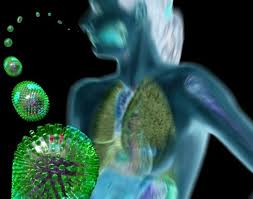Viruses serve many purposes. The body contains all kinds of viruses, including those considered deadly, but those are usually not only harmless, or inactive, but beneficial to the body’s overall balance.
The body maintains its vitality not only through the physical motion and agility that we perceive, but by microscopic agility, and actions within microseconds, that we do not perceive. There is as much motion, stimulation, and reaction in the interior bodily environment as the body meets through its encounters with the exterior environment. The body must now and then “flush its systems out,” run through its repertoire, raise its temperature, activate its hormonal actions more strongly. In such ways it keeps its system of immunities clear. That system operates always. To some extent, it is a way that the body distinguishes between self and nonself.
In certain fashions, that system also keeps the body from squandering its energies, preserving biological integrity. Otherwise it would be as if we did not know where our own house began or ended, and so tried to heat the entire neighborhood. So some indispositions “caused by viruses” are accepted by the body as welcome triggers, to clean out the system, and this applies to our present indispositions.
More is always involved, however, for those viruses that we consider communicable do indeed in one way or another represent communications on a biological level. They are biological statements, literally social communications, biologically made, and they can be of many kinds.
When a skunk is frightened, it throws off a foul odor indeed, and when people are frightened they react in somewhat the same fashion at times, biologically reacting to stimuli in the environment that they consider alarming. They throw off a barrage of “foul viruses” — that is, they actually collect and mobilize from within their own bodies viruses that are potentially harmful, biologically trigger these, or activate them, and send them out into the environment in self-protection, to ward off the enemy.
In a fashion this is a kind of biological aggression. The viruses, however, also represent tensions that the person involved is getting rid of. That is one kind of statement. It is often used in a very strong manner in times of war, or great social upheaval, when people feel frightened.
The olympic athlete may be charged by the great physical vitality that one feels watching that athletic panorama. [Because of that, and for other personal reasons], one could find no release for the intense energy one could feel, so one may get rid of it, protecting oneself, and throw our one ‘s threatening biological posture: the viruses.
Our normal bodies have not received any such goodies sometimes, so they exuberantly used them as triggers to regenerate the immune systems.
Many people had such reactions, coming from athletic events, in that they do not know how to use and release their own energies — as if they themselves felt put in an inferior position in comparison to such achievements.
There are all kinds of biological reactions between bodies that go unnoticed, and they are all basically of a social nature, dealing with biological communications. In a fashion viruses, again, are a way of dealing with or controlling the environment. These are natural interactions, and since we live in a world where, overall, people are healthy enough to contribute through labor, energy, and ideas, health is the dominating ingredient — but there are biological interactions between all physical bodies that are the basis for that health, and the mechanisms include the interactions of viruses, and even the periods of indisposition, that are not understood.
All of this has to do with man’s and woman’s intent and his or her understanding. The same relationships, however, do not only exist between human bodies, or course, but between man and woman and the animals and the plants in the environment, and is part of the unending biological communication that overall produces the vitality of physical experience.
One note on vitamins: they are most effectively used for periods of two or three weeks, where they act as stimuli and reminders to the body. Then drop their use for two or three weeks, so that the body then produces by itself those elements we have reminded it we want. Any steady use of vitamins is not to our overall benefit, for we give the body what it needs too easily, and its ability to produce such material on its own becomes sluggish.
Certain “diseases” are protections against other diseases, and the body on its own is its own excellent regulator.
Obviously those abilities operate best when we trust them. The body’s systems know what diseases are in the air, so to speak, and will often set up countermeasures ahead of time, giving us what we experience as an indisposition of one kind or another — but an indisposition that is actually a statement of prevention against another condition.
There is great traffic flow in a city: A body knows how to leap out of the way in a moment’s time from an approaching car. In the interior physical environment there is far greater traffic flow. There are decisions made in periods of time so brief we cannot imagine them — reactions that are almost over before responds to its inner reality, and to all the stimuli from the exterior environment. The body is an open system. As solid as it seems to us, there are constant chemical reactions between it and the world, electromagnetic adjustments, alterations of balance, changes of relationships — alterations that occur between the body and its relationship with every other physical event, from the position of the planets and moon and the sun, to the position of the smallest grain of sand, to the tiniest microbe in anyone’s intestine.
All of these adjustments are made without our conscious notice, and yet in with our overall purposes and intents.
Genes are elemental units arranged along the threadlike chromosomes in the nucleus of each cell, and transmit hereditary characteristics to following generations of animals and pants. The gene is primarily made up of protein and a twisted double strand of helix of DNA, or deoxyribonucleic acid. Each gene occurs at a specific location on a chromosome. We humans, for instance, have 46 chromosomes and an estimated 100,00 genes in each cell, and our genes provide the blueprints for the synthesis of some 50,000 proteins. I’m sure that our wonder at the vast organization of nature will continue to grow as our scientists plunger ever deeper into the complexities of genetic research. And what about the philosophical questions involving free will in all of this? Just how much real freedom do we have, if all is programmed by our genetic heritage? (I ask the question aside from the old, still-extant arguments within philosophy, psychology, and religion over whether free will has ever existed — or does — in any context. In addition, now we also have many newer questions about inherited genetic equality and/or inequality.
For that matter, one can ask the same questions about our supposed reincarnational heritage: Just how much free will does that concept leave us? Are we as fated to dance to unknown and unrealized nonphysical reincarnational events, tendencies, and goals, as we are to the physical, genetic ones — that is, do the two operate together? How immutable, or resistant to change, are those two endowments, and what parts of either one can we turn off if we choose to? Will the dissection of a gene, down even to its atomic components, ever yield reincarnational clues? Consciousness forms the genes, and not the other way around, and the about-to-be-born infant is the agency that add now material through the chromosomal structure.
Viruses and infections are always present. They are themselves fragments, struggling small fragments without intention of harm. We have general immunity, believe it or not, to all such viruses and infections. Ideally, we can inhabit a plane with them without fear. It is only when we give tacit agreement that harm is inflicted upon us by these fragments. To some degree, lesser, dependent lives such as household pets are dependent upon our psychic strength. They have their own, it it true, but unknowingly we reinforce their energy and health.
When ur own personalities are more or less in balance, we have no trouble at all in looking out for creatures, and actually reinforcing their own existence with residues of our creative and sympathetic powers. In times of psychological stress or crisis, quite unwittingly we without this strong reinforcement.
Animals certainly do have energy to maintain their own health, but this is strongly reinforced as a rule by the vitality of human beings to whom the animals are emotionally attached.
Animals, like people, sense when they are a burden.











